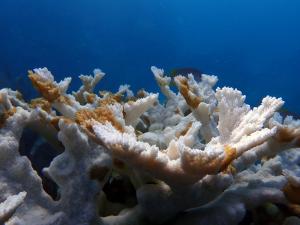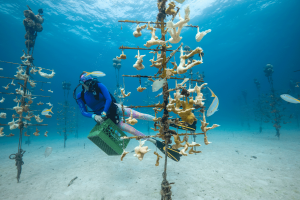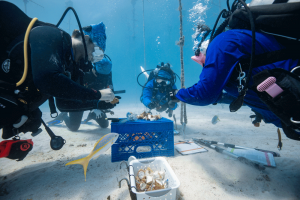
FLORIDA CORAL RESTORATION GROUPS BRACING FOR IMPACT AS FOURTH GLOBAL MASS BLEACHING EVENT ANNOUNCED
NOAA and ICRI announce Fourth Global Mass Coral Bleaching Event impacting reefs worldwide. CRF™ prepares for challenges and urges action on climate
“We need to understand that the threats our reefs are facing this year could take a variety of forms, particularly considering the current unpredictable climate patterns as we transition out of El Nino and possibly towards a La Niña cycle,” says Dr Phanor Montoya-Maya, Coral Restoration Foundation™ Restoration Program Manager, “We are intensively monitoring early warning systems like NOAA's Coral Reef Watch, satellite-based tools and models that monitor sea temperatures, and other environmental indicators, and we are preparing for any eventuality. This speaks to the heart of what we do at CRF™ – adaptive management and proactive planning.”
In the summer of 2023, the arrival of a climate-change-charged El Niño Cycle saw Coral Restoration Foundation™ (CRF™) and other coral groups in Florida forced to take unprecedented measures to safeguard the remaining genetic diversity of corals on Florida's Coral Reef as temperatures soared and coral began bleaching rapidly and in massive numbers.
The first group to raise the alarm on the arrival and severity of this now global phenomenon, Coral Restoration Foundation™ was prepared to respond. With the management of these kinds of risks built into the heart of their programs, CRF™ was quick to mobilize, working with NOAA and other local coral groups, moving their own corals as well as those of their partners to gene banking at two redundant land-based facilities. They then transferred about 10% of their nursery corals into land-based holdings at Keys Marine Lab and the Brinton Environmental Center, Florida Seabase, preserving vital coral stock in case the temperatures resulted in the death of all the corals in their ocean-based nurseries.
Aware that this heating event could likely have planet-wide impacts, the CRF™ Team took part in a bleaching webinar organized by the Coral Restoration Consortium, of which CRF™ is a founder and member of the executive team. The session was designed to alert collaborators in the Caribbean, Australia and other places to the severity of the incoming conditions and advise on steps to take to prepare for the worst. “CRF™ has a global approach and perspective,” says Jessica Levy, CRF™ Director of Restoration Strategy. “A big part of what we do is sharing knowledge and supporting other restoration efforts where needed.”
Once temperatures dropped in October of 2023, thanks to the scale at which CRF™ operates more than 20,000 corals still survived in their open ocean nurseries, and several hundred of their nursery-raised corals were still alive at Caryfort Reef and North Dry Rocks – a clear benefit of returning a total of more than 240,000 corals to Florida’s Coral Reef over the last 16 years. The CRF™ Team was able to move all of their evacuated corals back into the ocean by the end of the year and begin fragmenting and propagating survivors to rebuild their lost coral stock. CRF™ then started to prepare for another difficult summer.
With heat stress a likely threat, as the situation evolves, groups like CRF™ are also preparing for other potential disturbances including disease outbreaks and hurricanes. For the last several months, CRF™ has been proactively implementing mitigation strategies designed to address a variety of potential stressors. They have been:
• Reorganizing the Tavernier Coral Tree™ Nursery (the largest open ocean nursery in the world) separating trees of the same genotype to mitigate risks of disease transmission.
• Testing a preliminary coral shading structure that utilizes an easily deployed TV antenna-inspired frame topped with a semi-permeable cloth, strategically designed to reduce heat stress on growing corals on the CRF™ Coral Trees.
• Working with partners including Nova Southeastern University, who manage the redundant CRF™ in situ gene bank in Broward, to create space to hold corals that may need to be evacuated to cooler water in the north of the state.
• Embarking on a research collaboration with Dr Andrea Grottoli and team from Ohio State University to test a patent-pending coral feeding solution that not only can help corals survive the starvation that bleaching induces but also accelerate growth and recovery of resilient corals.
But, as the reality of unmitigated climate change is brought into stark relief, coral restoration work is increasingly being called into question. Dr R. Scott Winters, CRF™ CEO, challenges the naysayers: “We must remember that reef restoration is a vital component of a necessary three-pronged response to coral reef loss.
Reducing greenhouse gas emissions and removing local stressors on coral reefs such as pollution and overfishing are critical. But coral restoration work is also important – we are all that is standing in the way of the extinction of these animals. Our efforts are safeguarding important genetic diversity and developing large-scale techniques that we need to restore the ecological function of reef sites that we are losing. Ecosystem restoration work is also now being recognized as an important economic driver for coastal communities; a benefit that extends beyond the survival of the animals or plants whose populations are being recovered,”
“Despite the extraordinary challenges our coral reefs are facing, hope is not lost,” says Dr Montoya-Maya, “We bore the brunt of the Fourth Global Mass Bleaching Event and we still have tens of thousands thriving in our nurseries. After Hurricane Irma, we lost about 50% of the corals on our restoration sites. But in the two years following the storm, we rehomed more corals on the reefs than we did in the 10 years before it. This is a setback. A significant one, yes, but one that we know we can bounce back from. But this needs to be the wakeup call to the world that effective management and climate action is needed, now.”
Beth Vessels
Coral Restoration Foundation
email us here
Visit us on social media:
Facebook
Twitter
LinkedIn
Instagram
YouTube
EIN Presswire does not exercise editorial control over third-party content provided, uploaded, published, or distributed by users of EIN Presswire. We are a distributor, not a publisher, of 3rd party content. Such content may contain the views, opinions, statements, offers, and other material of the respective users, suppliers, participants, or authors.




